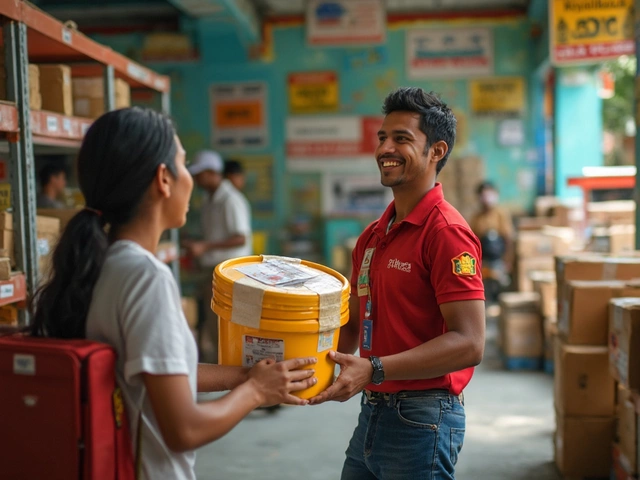If you ship packages regularly, you’ve probably heard about FedEx Ship Manager. People always ask: is it actually free, or is there a catch somewhere down the line? Turns out, the answer’s not as simple as a plain yes or no.
On the surface, FedEx Ship Manager sounds straightforward. Sign up, download the software, and start printing labels—no upfront payments or annual contracts for the core stuff. That’s a huge relief for small businesses trying to save cash. But there’s more to it if you dig below the basics. Some accessories and advanced features aren’t covered, and they can catch you off-guard.
It helps to know exactly what the free version gets you, and where you might run into surprise extras. I've seen people trip up on things like address validation costs or integration fees with certain e-commerce platforms. Stick around—I'll walk you through the essentials and how to steer around those sneaky pitfalls.
- What Is FedEx Ship Manager?
- Is FedEx Ship Manager Really Free?
- What Do You Get with the Free Version?
- Features That May Cost Extra
- Pro Tips for First-Time Users
- Common Pitfalls and How to Avoid Them
What Is FedEx Ship Manager?
Imagine trying to ship out dozens—or even hundreds—of packages every week. Doing it by hand is both slow and full of headaches. That’s where FedEx Ship Manager steps in. It’s FedEx’s own shipping software made to help anyone who sends out a lot of packages save time and avoid mistakes.
FedEx Ship Manager comes in two main flavors: the online version (you use this right in your browser) and the downloadable desktop version (you pop this on your computer). Most small businesses start with the online option since it’s easy—no need to install, and you just log in from anywhere. The desktop version, though, has some extra muscle. It’s great if you want to automate shipping, manage a big warehouse, or link the software to equipment like label printers and scales.
The software lets you:
- Create and print shipping labels for domestic and international packages
- Track shipments in real time without bouncing between screens
- Auto-fill sender and receiver info to dodge typos and double entries
- Check delivery dates and costs for each package
- Get customs paperwork ready if you ship worldwide
- Schedule pickups so you don’t have to drop off boxes yourself
One cool stat: as of early 2025, FedEx says that tens of thousands of businesses use FedEx Ship Manager daily, and the system handles millions of labels every month.
No extra upgrades are needed for simple day-to-day stuff like printing labels or scheduling a driver. But as your operation grows, you can hook up things like barcoding, inventory, or connect to e-commerce stores. That’s where the downloadable version has the edge—more flexibility, more automation, but a bit more setup.
Is FedEx Ship Manager Really Free?
Short answer: Yes, the core FedEx Ship Manager software is free. There’s no cost for downloading it, installing it on your computer, or using the basic shipping tools. FedEx wants you to ship with them, so they’ve made their shipping software itself totally no-charge for customers.
But here’s the thing—they do expect you to be an active FedEx account holder. When you sign up for the software, you’ll need a FedEx account number, and you can only use it to send packages through FedEx shipping services. No mixing and matching with other carriers.
So, where could you run into payments? The main program and the key features are free, but certain extras could cost you. For example, if you need fancy label printers, custom integrations with your inventory system, or advanced reporting, you might need to spend a little extra. Here’s a quick look at what’s usually free and what sometimes isn’t:
- Free: Core software (shipping labels, rate quotes, package tracking)
- Free: Access to FedEx support for basic software issues
- Costs extra: Special barcode/label printers and supplies
- Costs extra: Integrations with non-FedEx platforms or third-party e-commerce tools
- Costs extra: Some advanced reporting and analytics features, in specific business plans
FedEx does not charge hidden fees to use their standard FedEx Ship Manager software. But, don’t ignore the cost of things like shipping supplies or extra modules you might need if you’re running a bigger operation. If you’re just printing standard labels and tracking shipments, you probably won’t pay a cent for the software itself.
For businesses that ship a high volume—think hundreds or more a week—there are extra tools FedEx offers, like Ship Manager Server, which may require a special contract or setup fee. Small business owners usually won’t bump into these unless they really start scaling up.
| Feature | Cost |
|---|---|
| Downloading FedEx Ship Manager | Free |
| Printing basic shipping labels | Free |
| FedEx account setup | Free |
| Specialized label printers | Paid |
| 3rd-party integrations | Potentially Paid |
Bottom line: as long as you use it for basic shipping, the software won’t cost you extra. Just keep an eye on any hardware or advanced options that go beyond the basics of FedEx Ship Manager.
What Do You Get with the Free Version?
Here’s the deal with the free version of FedEx Ship Manager: it covers the basics without making you reach for your wallet or credit card. Once you’ve got your FedEx account, you download the software at zero cost. No license fees, and you don’t need to upgrade just to run regular shipments.
This is what you get, right out of the box:
- Shipment processing: Make domestic and international FedEx shipping labels, pick your service type (like FedEx Express or FedEx Ground), and print your labels in a few clicks.
- Address book: Store, manage, and reuse contacts so you’re not re-typing info for your regular customers.
- Tracking and reporting: Track packages as soon as you ship them, and pull up basic shipping reports any time you need them.
- Rate quotes: Check real-time shipping rates before you commit, helping you avoid sticker shock.
- Customs paperwork: For international shipments, the software helps generate the required documents, so your packages don’t get stuck at the border.
- Integration with scales and printers: Ship Manager works with most USB shipping scales and regular thermal printers, so you don’t need fancy hardware.
Everything listed above is available for free as long as you’re using it for your FedEx shipments. There’s no per-label fee, and FedEx doesn’t care how often you use it—daily shippers and once-in-a-while senders are all treated the same.
If you want a quick overview of what comes with the free version:
| Feature | Included in Free Version? |
|---|---|
| Label Printing | Yes |
| Address Book | Yes |
| Tracking | Yes |
| Rate Quotes | Yes |
| Reporting | Basic Only |
| Customs Forms | Yes |
| Integration with FedEx.com | Yes |
| Advanced Integrations (e-comm, ERPs) | No |
This setup is perfect for small businesses and people who want to get things shipped fast without dealing with complicated setups or hidden fees. As long as you keep your shipping needs simple, the free version should handle just about everything you need.

Features That May Cost Extra
So, you’ve got FedEx Ship Manager running and you’re printing labels for free. But before you start shipping hundreds of boxes, let’s talk about stuff that’s not part of the free deal. FedEx doesn’t charge for the basic software, but they do charge for certain extra features and tools. A lot of new users get caught off guard here.
Here’s where the hidden costs can show up:
- Integration with Custom Systems: Hooking up FedEx Ship Manager with complex ERP systems or custom software usually requires extra support services—either from FedEx or outside IT folks. This isn’t free, and you might see setup fees pop up.
- Specialty Hardware: FedEx ships you a free thermal label printer if you qualify, but if you want extra gadgets (like scales or barcode scanners compatible with Ship Manager), you’re picking up the tab for those. Some hardware bundles easily run over $300.
- Address Validation Services: Basic address checking is included, but advanced validation services (especially ones integrated with e-commerce platforms) can come with added fees. If you’re running lots of shipments, those little fees can stack up.
- Custom Report Generation: If you want Ship Manager to spit out special reports—maybe to track performance for multiple accounts or locations—you may have to pay for custom programming.
- Advanced API Access: Basic label printing is covered, but developers who want to tap into more advanced parts of the shipping system sometimes find out that full-access APIs or premium support mean more charges.
According to the FedEx Tech Support Center:
"While FedEx Ship Manager software is offered at no charge for basic shipping, certain integration and specialized tools may incur additional costs depending on your logistics needs."
Data from a 2024 survey of logistics users by Shipware showed that almost 23% of small businesses underestimated their total cost by missing these extras. Here’s a quick rundown:
| Feature | Potential Extra Cost |
|---|---|
| Thermal printer & scanner (additional) | $150–$400 |
| Software integration support | $200–$1,000+ |
| Address validation (advanced) | $0.05–$0.15 per use |
| API premium support | Up to $500/year |
Tip: Read the fine print before adding extras. If you need more than the out-of-the-box basics, ask a FedEx rep upfront about any setup or per-use charges that could hit your bottom line. Nobody likes a mid-year budget surprise.
Pro Tips for First-Time Users
Getting started with FedEx Ship Manager? You don’t want to learn the hard way, so here’s some solid advice that’ll save you time and headaches.
- Set up your account info right the first time. Double-check your business contact details and pickup addresses before you do anything else. If there’s a typo, your shipments might end up somewhere random, and fixing address mistakes with FedEx is way less fun than it sounds.
- Use the address book feature early. This handy tool can store regular customer and vendor addresses so you don’t have to type them every time. You’d be surprised how much faster you’ll breeze through label creation.
- Check printer compatibility. Some thermal printers need specific drivers to work with the software. If you’re not sure, stick with FedEx-recommended models from the start. Don’t waste your time troubleshooting blurry or missing barcodes.
- Understand dimensional weight charges. FedEx uses either the actual weight or dimensional weight for rates—whichever is higher. Measure your boxes carefully and enter the right numbers, or you might get charged more later on.
- Batch shipping is your friend. If you send out a lot of packages at once, use the batch shipping features in FedEx Ship Manager. This can cut your label printing time in half, and you’ll avoid clicking through the same screens a hundred times.
- Set up email notifications. The software can automatically email your customers tracking numbers as soon as the label is created. That little touch saves you from tons of “Where’s my package?” messages.
To give you an idea of how much time you could save, check out the rough numbers below. These estimates are based on user feedback from small business forums in 2024:
| Task | Manual Entry | With Ship Manager Tools |
|---|---|---|
| Address Input per Shipment | ~2 minutes | <30 seconds |
| Label Printing for 20 Orders | ~40 minutes | ~10 minutes (batch mode) |
| Emailing Tracking Info | ~15 minutes | Automatic |
Bottom line? FedEx Ship Manager will make things easier, but only if you invest a bit of time setting up and learning the shortcuts. Most people who run into issues just skip the tutorials. Don’t be that person—dig into the resources on FedEx’s help pages if you get stuck.
Common Pitfalls and How to Avoid Them
Using FedEx Ship Manager looks easy, but a bunch of folks run into the same mistakes over and over. These snags can waste time or even cost you money if you’re not careful.
Address validation fees surprise a lot of users. If you use certain integrations, you might get hit with small charges for validating recipient addresses. Not all addresses are checked for free, especially when you connect Ship Manager with external shipping carts or online stores.
Another classic headache? Setup with thermal label printers and scales. FedEx Ship Manager supports popular models, but getting them to play nice takes some effort. Miss one setup step, and you could be stuck reprinting piles of crooked or useless labels. Always check the compatibility list from FedEx before buying new hardware.
You should also watch for data sync issues. For example, if you run an e-commerce site and expect FedEx Ship Manager to grab your orders automatically, make sure you read the integration guide carefully. Botched imports and missed orders make businesses scramble. According to FedEx, "Integrating Ship Manager with your order system requires following exact specifications to avoid data loss and duplicate shipments."
FedEx recommends regularly double-checking your integration settings and running test shipments—especially during your first week using the software.
Here are a few ways to dodge the worst landmines:
- Check for hidden fees: Validate all your settings and integrations, especially address tools, to see if extra charges might sneak in.
- Start simple: Use Ship Manager’s basic features first before adding plugins or hooking it into your shopping site. Get the hang of the basics.
- Review hardware support: Double-check that your printers, scales, and barcode scanners match FedEx’s supported list. You can find the updated list on the FedEx website.
- Test before you go live: Try out all your shipping workflows with a couple of test shipments before you hit busy season.
- Back up your settings: If you’re making a lot of changes, keep backup copies of your settings and shipment templates. It saves headaches if you need to roll back.
When you remember these basics, you’ll spend way less time dealing with tech headaches and more time getting actual shipments out the door.





